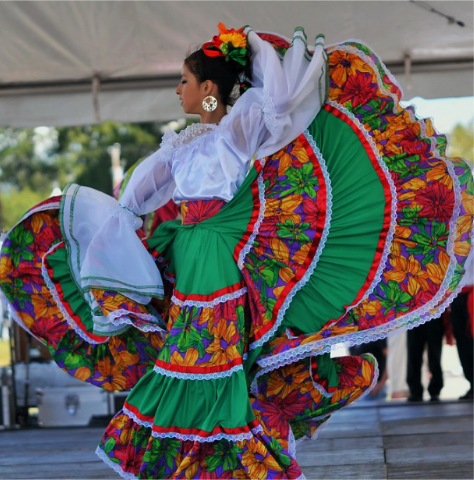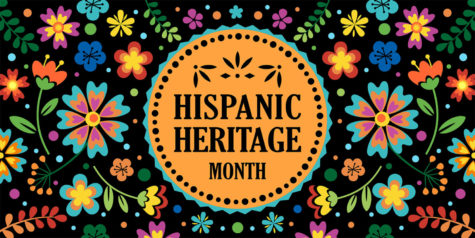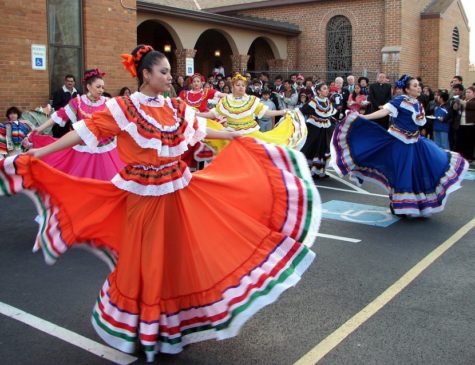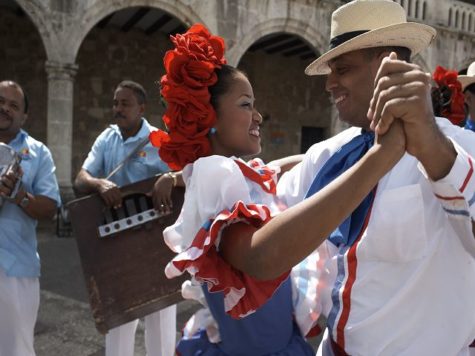Hispanic Heritage Month 2022 “Unidos: Inclusivity for a Stronger Nation”

September 20, 2022

Hispanic Heritage Month 2022 “Unidos: Inclusivity for a Stronger Nation”
Hispanic Heritage Month is a time from September 15 to October 15. This is a time for us to celebrate and educate others on our culture and its impact on history. This is not a time however for people to be shallow or ignorant when it comes to our culture. For non-Hispanic or Latino people, this month is for you to learn and listen to us about both our culture and the problems we face as a minority in America.
Now a lot of you might think that Hispanic Heritage month is something new that hasn’t been around that long. However, that’s not true. It first started in 1968 and only lasted a week. It was introduced by Congressman George E. Brown with large Latino groups in Los Angeles and San Gabriel Valley supporting and representing him. It was made as a response to the civil rights movement, as a way to highlight the multicultural society of America. It was then extended to 30 days by Ronald Reagan in 1988. The dates of September 15 to October 15 are important because they cover multiple independence days for Latin American countries including Mexico, El Salvador, Guatemala, Costa Rica, Nicaragua, Honduras, and Chile

Latino vs Hispanic, What’s the difference?
You may have noticed that I used both the terms “Latino” and “Hispanic” in the paper so far. These terms are often used interchangeably, describing generally the same group of people. However, there is a difference between the terms. Yes, there is a lot of overlap between them but even still, using them as the same word erases identities within them
Hispanic: relating to Spain or Spanish-speaking countries, especially those of Latin America; a Spanish-speaking person living in the US, especially one of Latin American descent. In simpler terms, Hispanic means you, your family, or your ancestors come from a country that speaks Spanish. This includes a lot of Latin America like Mexico, Puerto Rico, Cuba, Dominican Republic. But it also technically refers to people from Spain. However, Spanish people are European, which means that Spanish people aren’t treated as badly in our American society as Latin American Hispanic people.
Latino: a person of Latin American origin or descent. Countries in Latin America do commonly speak Spanish so Mexico, Guatemala, Costa Rica, and Chile are Latino countries. But countries like Brazil and Haiti are also Latino countries despite not speaking Spanish. People in Brazil speak Portuguese while they Speak French Creole in Haiti. Spanish people, however, as in people from Spain, are not Latino. Another thing to note is that in recent years, many people have asked for the term “Latino” to change. In Spanish, many words have genders. For example, Latino is generally considered masculine while Latina is femmine. Because of this, in recent years many people have tried to make a gender-neutral term for Latinos. Technically, Latino is gender neutral but still has masculine connotations. One of the most controversial alternatives is Latinx, a term coined sometime in the early 2000s. Even though it is gender inclusive, it does not make sense grammatically in Spanish and it’s impossible to pronounce. Latinx uses English forms of gender neutrality which is erasing Spanish from the term. A newer one is Latine, using the e as in Spanish, e is formal and neutral as well as fitting in with Spanish grammar

Movies and Shows To watch
Here I will give a list of movies and shows written and starring Hispanic people as well as showing our culture or problems we face
-
- Encanto(2021): Everyone by now has heard of Encanto. This highest-grossing Disney film tells the story of family and making your own path in a Colombian Family. Its music was composed by Lin-Manuel Miranda, a Puerto Rican composer and musician known for writing the musicals “Hamilton” and “In the Heights”. This film has themes of family, community, individuality, and facing familiar trauma
- La Llorona(2019): This is not the American-made “Curse of La Llorona”, no, this film is a Guatemalan horror film written and directed by Jayro Bustamante. This classic Folktale is rewritten and set in Guatemala during political turmoil after a genocide of the Maya people. It deals with themes of Racism, Colonization, Revolution, and Classism, and shows how in Hispanic communities, we still have issues of our own to deal with(Tw: this film also features graphic content)
- Frida. Viva la Vida(2019): A documentary discussing the life and times of famous Artist and revolutionary Frida Kahlo. It features both all of her iconic art and fashion, but also her struggles with relationships and her frail body. It deals with themes of Mexican culture and art, philosophy, Toxic relationships, and the trials of having chronic illnesses
- Spare Parts(2015): Based on a true story, this film takes place in Arizona and follows a group of Mexican high school students and their teacher entering a robotics competition despite having little experience or funds. An uplifting tale that discusses topics such as Immigration, Living in America as a minority, and overcoming obstacles with creativity and determination
Cultural appropriation vs appreciation
In the last few years, a topic about the appropriation of other cultures has come into view. However, not many people even know what that means or how to avoid it. So I shall explain everything you need to know about this topic and how it applies to Hispanic culture.
“Cultural appropriation is the inappropriate or unacknowledged adoption of an element or elements of one culture or identity by members of another culture or identity. This can be controversial when members of a dominant culture appropriate from minority cultures.” In short, If you take something from another culture such as food or clothing, and using inappropriately or fail to acknowledge its origin, that’s cultural appropriation. This also includes where you are sourcing it from as well, meaning if you buy items from a culture being sold from someone NOT from that culture, that can also count as appropriation.
This does not mean that you can’t enjoy other cultures many people encourage you to enjoy them. The main thing to remember is that often in America, culture is stripped from people so you must be careful when exploring culture. When you want to know if you are appropriating or appreciating, here are 3 tips
- Do you know where it came from?
- Are you using it appropriately?
- Are you telling others what culture it is from if they ask?
Following these tips will help you avoid it.
Many people might think that appropriating culture is not harmful at all, but it is. Because minorities face so much negativity for their traditions, it’s almost hypocritical to then steal it and use it as your own. This is especially harmful if you rename or rebrand it to seem “appealing”. A good example of this is how over the summer, non-mexican tiktokers were making a traditional Mexican drink called Agua Frescas and renaming them as “Spa water” and claiming to have made it up themselves. Not only is it erasing its Mexican origin, but it is also bad when you realize our street vendors who sell agua frescas are often harassed and called “unsanitary”. To help drive this point home, here are some examples of appropriation vs appreciation
- Appropriation: Jessica throws a Quinceanera for herself, despite not being Hispanic, and does not invite her Hispanic friends to it since they all complained about it
- Appreciation: Jessica goes to a Quinceanera for her friend, Lupita, and enjoys traditional food and music as well as deciding to have a big party for her sweet 16th
- Appropriation: Jack and his girlfriend Maya buy and wear a “Drunk Mexican” and “Spicy Senorita” stereotypical Halloween costume to a party. They make everyone else uncomfortable but call them all sensitive babies despite perpetuating stereotypes
- Appreciation: Jack and Maya wear traditional Mexican attire after their friend invited them to a local festival. They wear the outfits respectfully and do not make fun of them and everyone compliments them on their outfits.
- Appropriation: Cathy makes and sells Puerto Rican food, but instead renames it and claims she invited it. Cathy is not Puerto Rican but profits from their culture without giving credit
- Appreciation: Cathy learns traditional Puerto Rican recipes from a friend and makes them for herself and her friends, telling them it’s Puerto Rican and where she learned it from.
Local ways to celebrate
There are many ways to celebrate Hispanic culture this month in Bonner and Kansas City. Here I will give a list of Hispanic-owned restaurants and businesses to visit or upcoming events
- Tropicana/Palacana: For the past 17 years, this restaurant has been owned and run by a Mexican family where they sell traditional Mexican ice cream and food. They specialize in Michoacan style ice cream, a hand-made ice cream known for its thick and folded texture, as well as serving traditional foods such as Chilaquiles, Flautas, and Tortas. Located in Kansas City and in the metro area, make sure to visit for a sweet treat or spicy snack

KCSourceLink. (2018, September 5). How one family of KC entrepreneurs is building a Mexican ice-pop empire. KCSourceLink. Retrieved September 20, 2022, from https://www.kcsourcelink.com/blog/post/blog/2018/09/05/paleterias-tropicana-is-building-a-mexican-frozen-pop-ice-cream-empire-in-kansas-city




